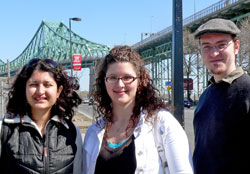Southeast Montreal revived

Urban Planning students (from left) Amita Dixit, Stavroula Tomaras and Cedric Capacchione at the corner of De Lorimier and Ste. Catherine in front of the Jacques Cartier Bridge. They’d like an open-air market there.
Photo by marc losier
Historic Ste. Marie was this year’s focus for students in Professor Pierre Gauthier’s Advanced Urban Laboratory.
The neighbourhood was once home to families of port and industrial workers in southeastern Montreal’s Ville Marie borough in the early 1900s. Now it’s a no man’s land.
Day after day, for decades, commuters have driven through its unsightly parking lots, ‘brownfields’ (contaminated land) and 30 lanes of traffic to get to and from work, because the area offers little reason to stay.
However, its proximity to Papineau metro, its lovely skyline views and its history as a point of entry to Montreal via the Jacques Cartier Bridge make it an intriguing district for potential rebirth.
Gauthier feels planners have “to heal the physical, social and environmental scars created by these automobile-based initiatives.”
His class started in September, and presented their results on March 30.
Architect and adjunct McGill urban planning professor Miguel Escobar attended the presentations and liked what he saw.
“It’s an area in transition right now, and requires a lot of research, which they have done. They were very realistic in their approaches,” he said. Several city planners also attended the presentations.
Apart from the deindustrialization of the area, which left many empty factories and parking lots in its wake, Gauthier blames the district’s erosion on the construction of the Ville-Marie expressway in the 1960s and the development of the CBC and Molson complexes in the ’70s.
The CBC building alone demolished 11 blocks of housing. Consequently all the local businesses and amenities, especially along Ste. Catherine St., shut down.
Cedric Capacchione, Amita Dixit and Stavroula Tomaras proposed a welcoming “gateway” into Ste. Marie under the Jacques Cartier Bridge.
It would be more symbolic than literal, using lighting effects and local artwork as markers, but would certainly improve on the grey sea of parking lots currently eating up land along Notre Dame St. E.
Capacchione, who is VP academic of the Urban Planning Association, explained the gateway as “a frame for people entering the city. It should be played up to create a sense of grandeur.”
The public would enter the Marché Papineau Market, an open-air market akin to Marché Jean Talon, between Dorion St. and De Lorimier Ave. along the south side of Ste. Catherine St. E.
“Markets tend to be on the internal peripheries of neighbourhoods because the value of the land is less and can cater to more than one community,” Gauthier explained.
After the gate and market spark an anticipated revitalization of the area, the group proposes that new housing be built.
A vacant 40,000-square-metre plot of land at the southeast corner of Ste. Catherine St. E. and De Lorimier Ave. could be used for the development of condominiums and Montreal-style triplexes.
The condos would be built along the land’s southern perimeter shielding the triplexes and adjacent community park from traffic noise.
“From there you can really see the city. Planners should always capitalize on the views,” Escobar said. “We [as planners] need to look outside the box. What are the assets that are unique to the town or neighbourhood that nobody can compete with?”
